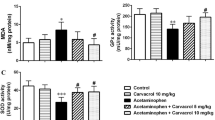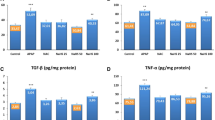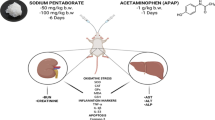Abstract
Acetaminophen (APAP) induced toxicities have been a major problem in clinical practice. The aim of the present study was to demonstrate a possible protective role of erdosteine, a mucolytic agent having antioxidant properties via its active metabolites, on APAP induced renal damage in rats. Female Wistar Albino rats were divided into groups including control, erdosteine (150 mg/kg, oral), APAP (1 g/kg, oral) APAP+erdosteine (150 mg/kg, oral) and APAP+erdosteine (300 mg/kg, oral). APAP treatment caused lipid peroxidation as well as high NO level in renal tissue. Also, APAP treated rats had decreased activities of CAT and GSH-Px, but not SOD. In addition, tubular epithelial degeneration, vacuolization and cell desquamation were clearly observed in the APAP treated rats. The cellular debris in the proximal tubules and cortical interstitial congestions were prominent in the kidneys of APAP treated rats. BUN and creatinine levels were increased after APAP administration. All these pathological changes were reversed after erdosteine treatments. Erdosteine treated APAP groups showed milder tubular degeneration, epithelial vacuolization in the proximal tubules, lesser cellular desquamation and better morphology when compared with APAP groups. In conclusion, erdosteine may be a choice of preventive treatment against APAP induced nephrotoxicity.
Similar content being viewed by others
References
Nelson S, Nelson D: Mechanisms of the formation and disposition of reactive metabolites that can cause acute liver injury. Drug Metab Rev 27:147–177, 1995
Placke ME, Wyand DS, Cohen SD: Extrahepatic lesions induced byacetaminophen in the mouse. Toxicol Pathol 15: 381–387, 1987
Zaher H, Buters JT, Ward JM, Bruno MK, Lucas AM, Stern ST: Protectionagainst acetaminophen toxicity in cyp 1A2 and cyp 2E1 double null mice. Toxicol Appl Pharmacol 52: 193–199, 1998
Matthews AM, Roberts DW, Hinson JA, Pumford NR: Acetaminophen induced hepatotoxicity. Analysis of total covalent binding versus specific bindingto cysteine. Drug Metab Dispos 24: 1192–1196, 1996
Tukel SS: Effects of acetaminophen on methemoglobin, superoxide dismutaseand Na(+)−K+ ATPase activities of human erythrocytes. Biochem Mol Biol Int 35: 719–724, 1995
Kapiotis S, Sengoelge G, Hermann M, Held I, Gmeiner BM: Paracetamolcatalyzes myeloperoxidase-initiated lipid oxidation in LDL. Arterioscler Thromb Vasc Biol 17: 2855–2860, 1997
Chaika LA, Povolotskaia VA, Libina VV, Rosliakov AD, Petrenko Aiu: The effect of paracetamol and its combinations with acetylsalicylic and ascorbicacids on lipid peroxidation processes in the rat liver. Eksp Klin Farmakol 59: 43–46, 1996
El-Ridi MR, Rahmy TR: Action of vitaminC against acetaminophen-inducedhepatorenal toxicity in rats. J Toxicol — Toxin Reviews 19, 275–304, 2000
Hart SG, Beierschmitt WP, Wyand DS, Khairallah EA, Cohen SD: Acetaminophen nephrotoxicity in CD-1 mice. I. Evidence of a role for in situ activation in selective covalent binding and toxicity. Toxicol ApplPharmacol 126: 267–275, 1994
Squadrito, GL, Pryor WA: Oxidative chemistry of nitric oxide: the roleof superoxide, peroxynitrite and carbon dioxide. Free Radic Biol Med 25: 392–403, 1998
Gazzani G, Fregnan GB, Vandoni G: In vitro protection by erdosteineagainst oxidative inactivation of alpha-1-antitrypsin by cigarette smoke. Respiration 55: 113–118, 1989
Fadillioglu E, Erdogan H, Sogut S, Kuku I: Protective effects of erdosteine against doxorubicin-induced cardiomyopathy in rats. J ApplToxicol 23: 71–74, 2003
Yagmurca M, Fadillioglu E, Erdogan H, Ucar M, Sogut S, Irmak MK: Erdosteine prevents doxorubicin-induced cardiotoxicity in rats. PharmacolRes 48: 377–382, 2003
Ozyurt H, Yildirim Z, Kotuk M, Yilmaz HR, Yagmurca M, Iraz M, Sogut S, Gergerlioglu S: Cisplatin-induced acute renal failure is ameliorated byerdosteine in a dose-dependent manner. J Appl Toxicol 24: 269–275, 2004
Ricevuti G, Mazzone A, Uccelli E, Gazzani G, Fregnan GB: Influence of erdosteine, a mucolytic agent, on amoxycillin penetration into sputum inpatients with an infective exacerbation of chronic bronchitis. Thorax 43: 585–590, 1988
Giovanni LD, Fregnan GB, Rabitti C, Murari G, Amato A, Sovera A, Civello IM. Lack of gastric adverse effect of erdosteine in rats and men. Int J ClinPharmacol Toxicol 29: 269–273, 1991
Esterbauer H, Cheeseman KH: Determination of aldehydic lipid peroxidation products: malonaldehyde and 4-hydroxynonenal. Methods in Enzymology. vol 186, Oxygenradicals in biological systems, Packer L. and Glazer A.N. (eds). Academic Press: California; 407–421, 1990
Cortas NK, Wakid NW: Determination of inorganic nitrate in serum andurine by a kinetic cadmium-reduction method. Clin Chem 36: 1440–1443, 1990
Sun Y, Oberley LW, Li Y: A simple method for clinical assay of superoxide dismutase. Clin Chem 34:497–500, 1988
Aebi H. Catalase. In: Bergmeyer HU, editor. Methods of Enzymatic Analysis. Academic Press: New Yorkand London, 673–677, 1974
Paglia DE, Valentine WN: Studies on the quantitative and qualitativecharacterization of erythrocyte glutathione peroxidase. J Lab Clin Med 70: 158–170, 1967
Lowry O, Rosenbraugh N, Farr L. Rondall R: Protein measurement with thefolin-phenol reagent. J Biol Chem 183: 265–275, 1951
Blazka, ME, Wilmer JL, Holladay SD, Wilson RE, Luster MI: Role ofproinflammatory cytokines in acetaminophen hepatotoxicity. Toxicol Appl Pharmacol 133: 43–52, 1995
Lewerenz V, Hanelt S, Nastevska C, El-Bahay C, Rohrdanz E, Kahl R: Antioxidants protect primary rat hepatocyte cultures against acetaminophen-induced DNA strand breaks but not againstacetaminophen—induced cytotoxicity. Toxicology 191: 179–187, 2003
Knight TR, Ho YS, Farhood A, Jaeschke H: Peroxynitrite is a critical mediator of acetaminophen hepatotoxicity in murine livers: protection byglutathione. J Pharmacol Exp Ther 303: 468–475, 2002
Fadillioglu E, Yilmaz HR, Erdogan H, Sogut S: The activities of tissue xanthine oxidase and adenosine deaminase and the levels of hydroxyproline and nitric oxide in rat hearts subjected to doxorubicin: protective effectof erdosteine. Toxicology 191: 153–158, 2003
Gardner CR, Heck DE, Yang CS, Thomas PE, Zhang XJ, DeGeorge GL, Laskin JD, Laskin DL: Role of nitric oxide in acetaminophen-induced hepatotoxicityin the rat. Hepatology 27: 748–754, 1998
Yagmurca M, Erdogan H, Iraz M, Songur A, Ucar M, Fadillioglu E: Caffeic acid phenethyl ester as a protective agent against doxorubicinnephrotoxicity in rats. Clin Chim Acta 348: 27–34, 2004
Li C, Liu J, Saavedra JE, Keefer LK and Waalkes MP: The nitric oxide donor, V-PYRRO/NO, protects against acetaminophen-induced nephrotoxicity.Toxicology 189: 173–180, 2003
Manautou JE, Silva VM, Hennig GE and Whiteley HE: Repeated dosing with the peroxisome proliferators clofibrate decreases the toxicity of modelhepatotoxic agents in male mice. Toxicology 127: 1–10, 1998
Author information
Authors and Affiliations
Corresponding author
Rights and permissions
About this article
Cite this article
Isik, B., Bayrak, R., Akcay, A. et al. Erdosteine Against Acetaminophen Induced Renal Toxicity. Mol Cell Biochem 287, 185–191 (2006). https://doi.org/10.1007/s11010-005-9110-6
Received:
Accepted:
Published:
Issue Date:
DOI: https://doi.org/10.1007/s11010-005-9110-6




